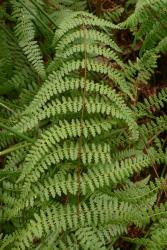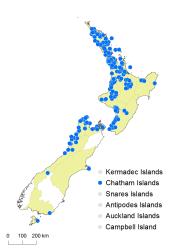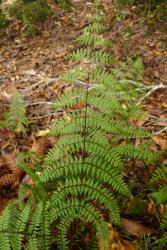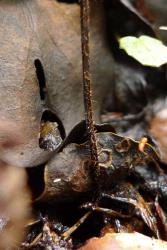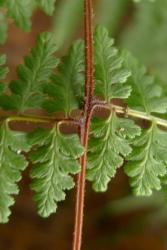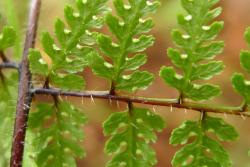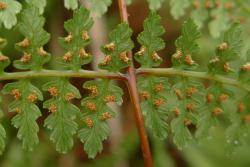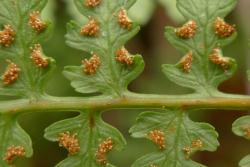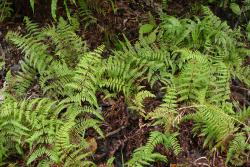Rhizomes long-creeping, 1–2.5 mm diameter, with stipes arising 5–110 mm apart; bearing red-brown or chestnut-brown hairs up to 5 mm long. Fronds 120–1700 mm long. Stipes 15–600 mm long, 0.75–1.25 mm diameter, dark red-brown, polished, bearing scattered red-brown non-glandular hairs up to 3 mm long. Rachises red-brown, becoming paler only at the distal end, bearing scattered chestnut-brown non-glandular hairs up to 1 mm long. Laminae usually deeply 2-pinnate-pinnatifid, rarely 2- or 3-pinnate, narrowly elliptic or elliptic or narrowly ovate or ovate, tapering to a very short pinnatifid apex, 105–1280 mm long, 45–390 mm wide, light green on both surfaces, coriaceous; a few scattered pale brown non-glandular hairs on abaxial lamina surface and costae but absent from lamina margin, up to 0.5 mm long. Primary pinnae in 15–40 pairs below pinnatifid apex, widely spaced, narrowly ovate, narrowly winged; the proximal pair arising at c. 90° to rachis; the longest at or below the middle, 25–210 mm long, 8–75 or rarely to 82 mm wide, apices acuminate, bases short-stalked or sessile. Secondary pinnae decreasing very gradually in length along primary pinnae to the distal end, winged throughout; the longest ovate to narrowly ovate, 4–50 mm long, 2–12 mm wide, apices acute or obtuse, bases sessile or shortly stalked, deeply divided or divided to the midrib in largest fronds. Tertiary pinnae ovate, 2–7 mm long, 1–3 mm wide, apices obtuse, bases adnate, margins rarely deeply divided. Veins reaching margin at a sinus. Sori ± round, protected by reflexed toothed lamina flaps; paraphyses absent. Mean spore size 31–34 μm long, 19–21 μm wide; perispores dark brown, reticulate, lacking obvious projections.
Hypolepis distans is a very distinct species recognised by its polished red-brown stipes, relatively narrow laminae, coriaceous texture, pinnae that arise at c. 90° to the rachis, veins that reach the margin at a sinus, well-developed indusia and dark brown spores that lack obvious projections.
North Island: Northland, Auckland, Volcanic Plateau, Gisborne, Taranaki, Southern North Island.
South Island: Western Nelson, Sounds-Nelson, Westland, Canterbury, Southland.
Chatham Islands, Stewart Island.
Altitudinal range: 0–750 m.
In the North Island Hypolepis distans occurs in coastal and lowland sites from near Kaitāia to Wellington, but is absent from much of the central high country and uncommon on the eastern side of the island. It reaches 750 m in the Herangi Range. In the South Island it is common only in coastal and lowland areas of the Marlborough Sounds, north-west Nelson and Westland as far south as the Haast River, with very scattered records on the east coast from Akaroa, the Catlins district and Stewart Island. It reaches 300 m in the Marlborough Sounds. It has also been recorded from the Chatham Islands.
Also Australia (Tasmania and King Island). Naturalised on Norfolk Island and possibly King Island (de Lange 2000).
Grows in swampy areas, bordering wetlands, on the bases of Carex secta in bogs, on peat or soils with a deep humus layer, in drainage ditches, on river terraces, on disturbed soils, on decomposing logs and humus mounds, in clearings, on road banks and forest margins. The weak stipes of H. distans are unable to support the laminae, and plants often scramble over the substrate forming a mound of rhizome and fronds, or less commonly climb up through other vegetation. In northern New Zealand it is found in kauri forest or mānuka, but further south it grows under podocarp or broadleaved forest, or under mānuka and kānuka. It is also found under pines.
n = 28 (Brownsey 1983; Brownsey & Chinnock 1984). This number is unique in the genus, and its significance has been discussed by Brownsey (1983).



